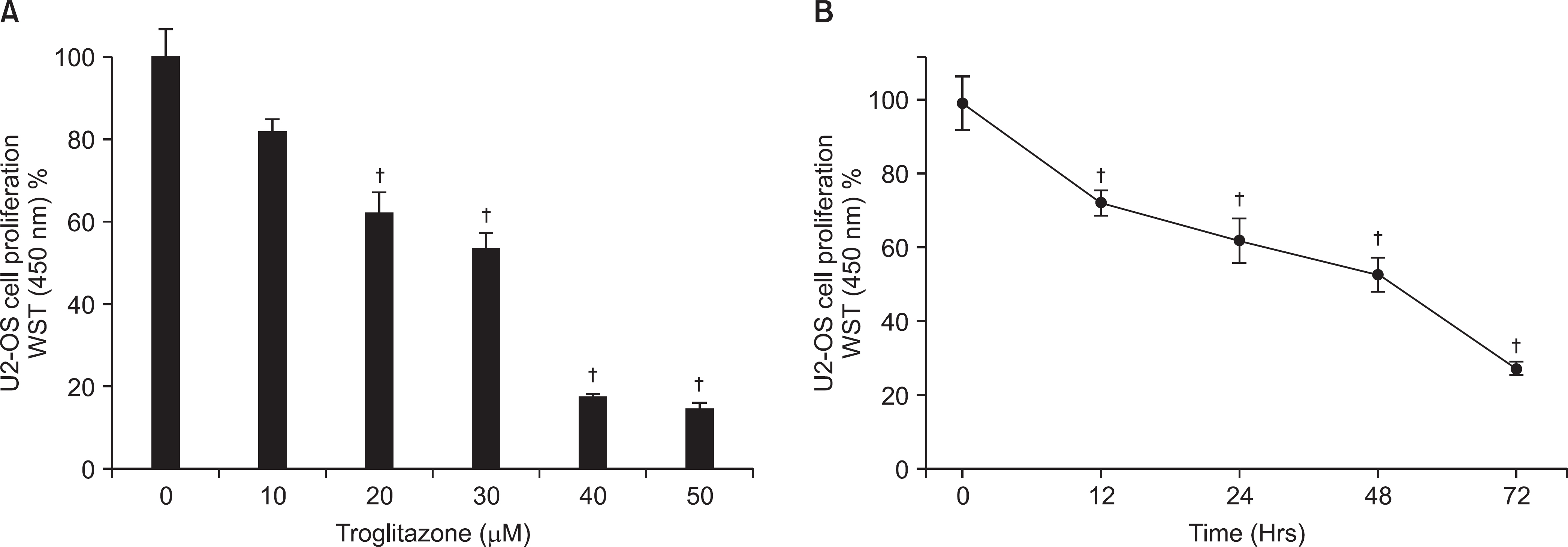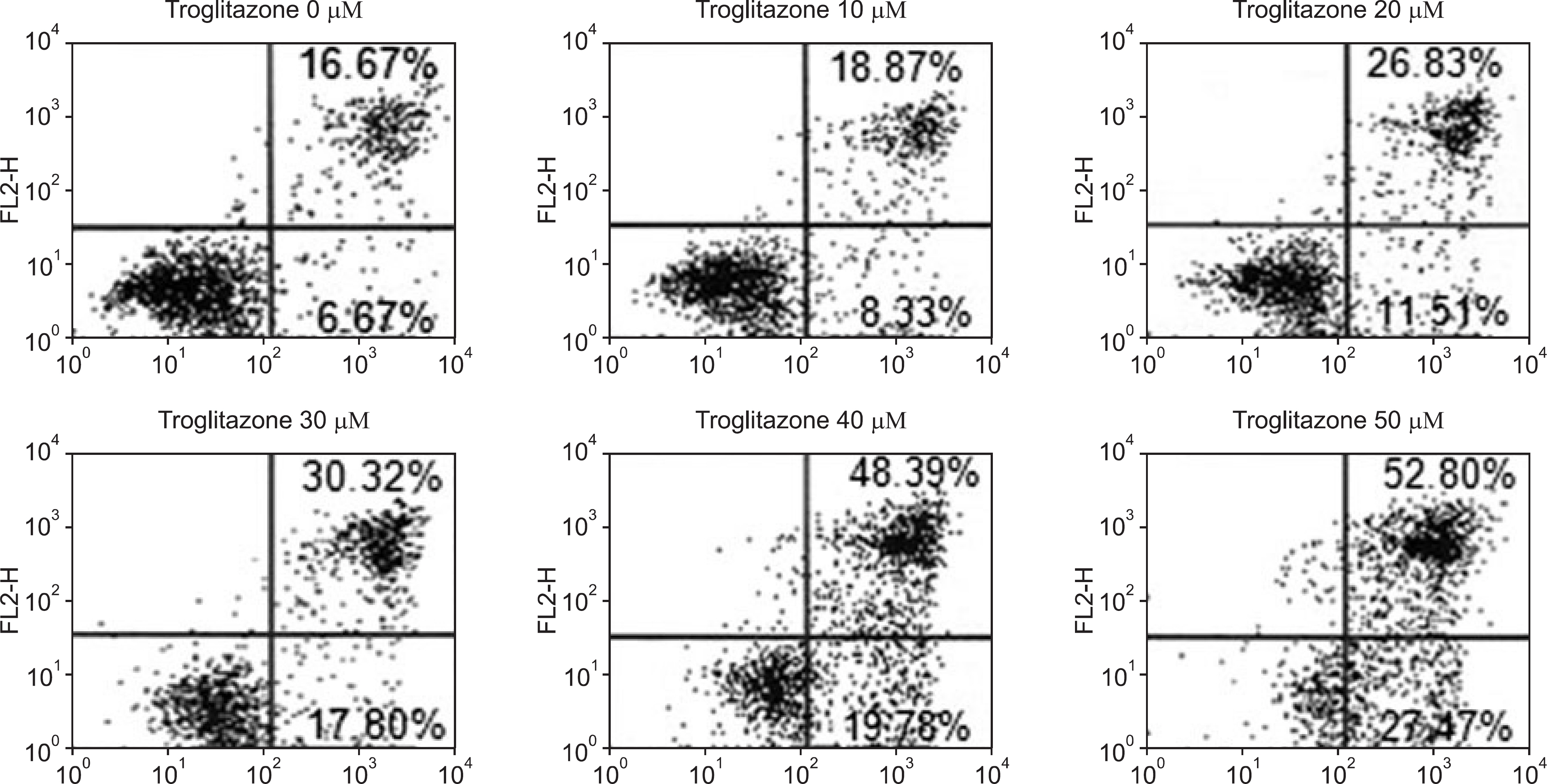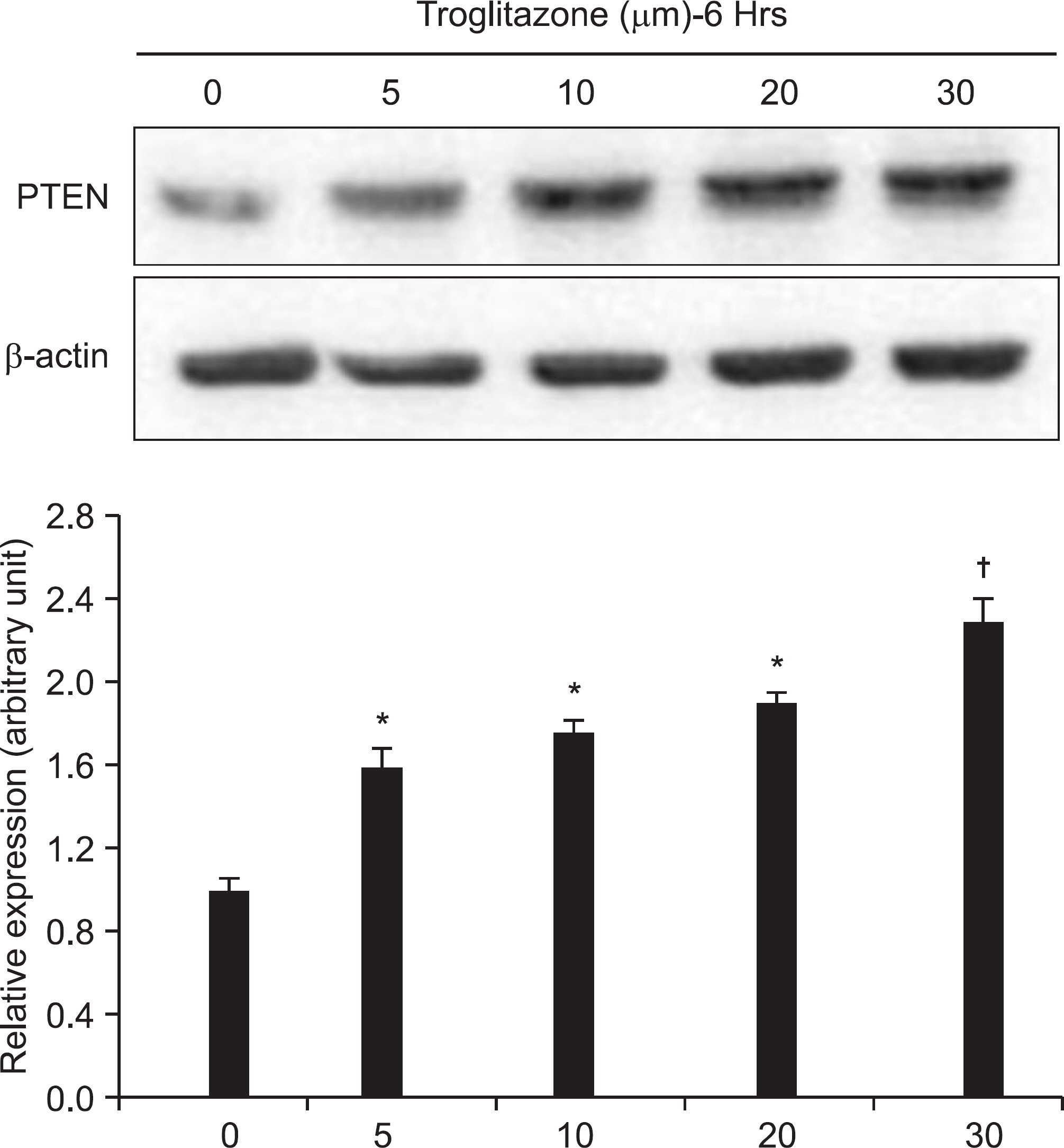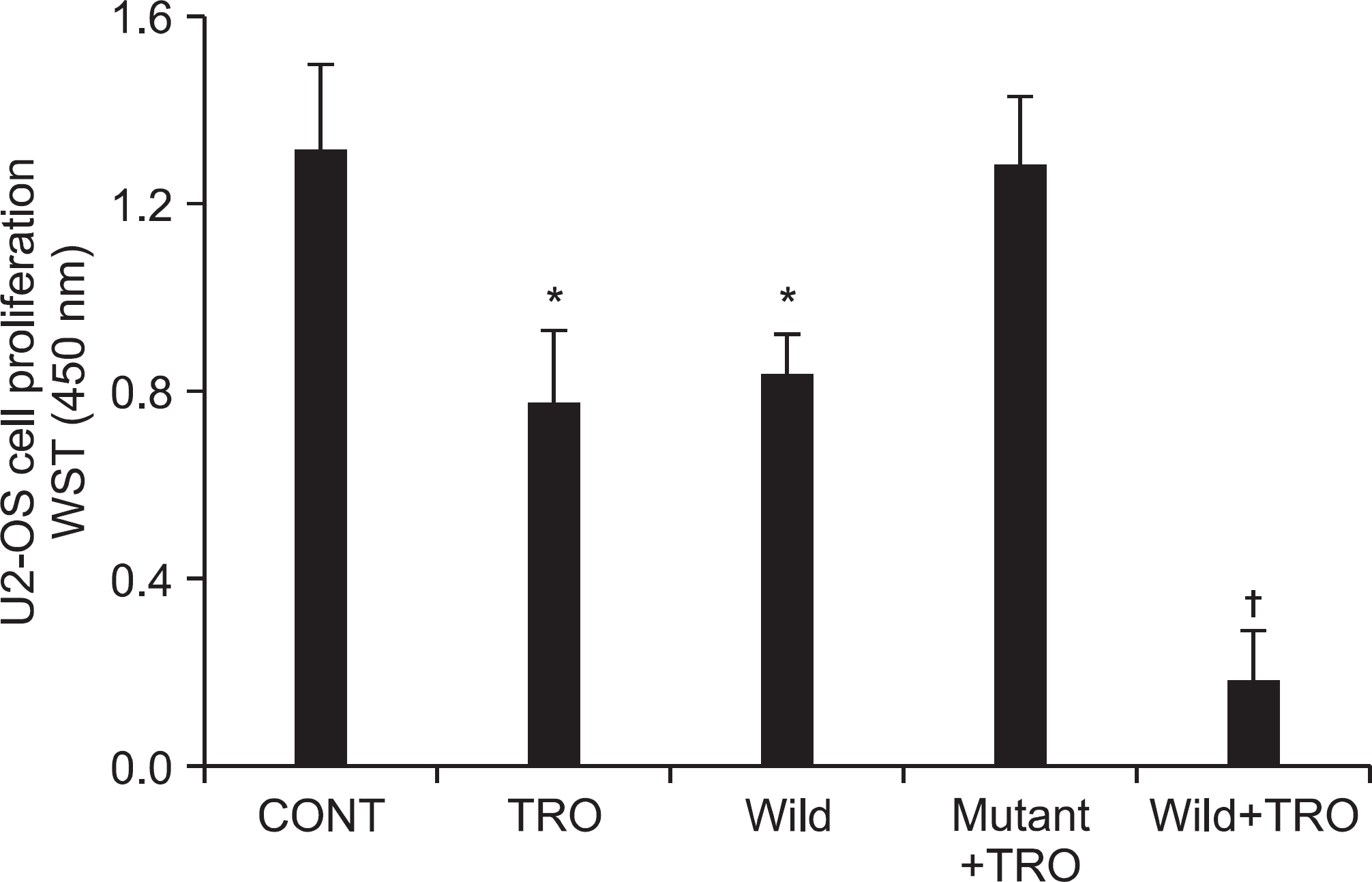J Korean Bone Joint Tumor Soc.
2011 Jun;17(1):23-29. 10.5292/jkbjts.2011.17.1.23.
Over-expression of PTEN Involved in Troglitazone-induced Apoptosis in Human Osteosarcoma Cells
- Affiliations
-
- 1Department of Orthopaedic Surgery, Medical School and Research Institute for Endocrine Science, Chonbuk National University, Jeonju, Korea. jrkeem@jbnu.ac.kr
- KMID: 2137040
- DOI: http://doi.org/10.5292/jkbjts.2011.17.1.23
Abstract
- PURPOSE
We investigated the effects of phosphatase and tensin homologue deleted on chromosome 10 gene phosphatase and tensin homologue deleted on chromosome 10 gene (PTEN) expression on the cell proliferation and on the responsiveness of troglitazone in osteosarcoma cells.
MATERIALS AND METHODS
Western blotting alnalysis was performed to detect the expression of PTEN in U-2OS cells treated with troglitazone. WST (water-soluble tetrazolium) assay was used to evaluate cell proliferation. Flow cytometry was used to determine cell apoptosis. Further, transfection of wild-type PTEN plasmid DNA was used to upregulate PTEN expression.
RESULTS
Troglitazone treatment induced growth inhibition of U2-OS cells in a dose- and time-dependent manner. Troglitazone increased the expression of PTEN in a dose-dependent manner. PTEN upregulation induced by troglitazone treatment resulted in cell growth inhibition and apoptosis in U-2OS cells. PTEN over-expression by plasmid transfection enhanced these effects of troglitazone. Moreover, no changes were observed in the mutant type-PTEN group.
CONCLUSION
Upregulation of PTEN is involved in the inhibition of cell growth and induction of cell apoptosis by troglitazone. Further, PTEN over-expression can cause cell growth inhibition in osteosarcoma cells and these cell growth inhibitions could be enhance by troglitazone treatment.
Keyword
MeSH Terms
Figure
Reference
-
1. Bramwell VH. Osteosarcomas and other cancers of bone. Curr Opin Oncol. 2000; 12:330–6.
Article2. Koeffler HP. Peroxisome proliferator-activated receptor gamma and cancers. Clin Cancer Res. 2003; 9:1–9.3. Young PW, Buckle DR, Cantello BC, et al. Identification of high-affinity binding sites for the insulin sensitizer rosiglitazone (BRL-49653) in rodent and human adipocytes using a radioiodinated ligand for peroxisomal proliferator-activated receptor gamma. J Pharmacol Exp Ther. 1998; 284:751–9.4. Kim KY, Kim SS, Cheon HG. Differential anti-proliferative actions of peroxisome proliferator-activated receptor-gamma agonists in MCF-7 breast cancer cells. Biochem Pharmacol. 2006; 72:530–40.5. Leslie NR, Bennett D, Lindsay YE, Stewart H, Gray A, Downes CP. Redox regulation of PI 3-kinase signalling via inactivation of PTEN. EMBO J. 2003; 22:5501–10.
Article6. Kim JY, Kim TK, Park JY, Kim HJ, Lee JW. Effects of the peroxisome proliferator-activated receptor ligand troglitazone in osteosarcoma cell lines. J Korean Orthop Assoc. 2005; 40:591–7.
Article7. Ishiyama M, Miyazono Y, Sasamoto K, Ohkura Y, Ueno K. A highly water-soluble disulfonated tetrazolium salt as a chromogenic indicator for NADH as well as cell viability. Talanta. 1997; 44:1299–305.
Article8. Ali IU, Schriml LM, Dean M. Mutational spectra of PTEN/MMAC1 gene: a tumor suppressor with lipid phosphatase activity. J Natl Cancer Inst. 1999; 91:1922–32.
Article9. Zhou XP, Gimm O, Hampel H, Niemann T, Walker MJ, Eng C. Epigenetic PTEN silencing in malignant melanomas without PTEN mutation. Am J Pathol. 2000; 157:1123–8.
Article10. Moon SH, Lee SH, Kim HS, Kim CH, Chung TW. Phosphatase and Tensin Homologue Deleted on Chromosome 10) in Osteosarcoma. J Korean Orthop Assoc. 2003; 38:39–46.11. Maehama T, Dixon JE. The tumor suppressor, PTEN/MMAC1 dephosphorylates the lipid second messenger, phosphatidylinositol 3,4,5-triphosphate. J Biol Chem. 1998; 273:13375–8.12. Stoll V, Calleja V, Vassaux G, Downward J, Lemoine NR. Dominant negative inhibitors of signalling through the phos-phoinositol 3-kinase pathway for gene therapy of pancreatic cancer. Gut. 2005; 54:109–16.
Article13. Pedrero JM, Carracedo DG, Pinto CM, et al. Frequent genetic and biochemical alterations of the PI 3-K/AKT/PTEN pathway in head and neck squamous cell carcinoma. Int J Cancer. 2005; 114:242–8.14. Kreisberg JI, Malik SN, Prihoda TJ, et al. Phosphorylation of Akt (Ser473) is an excellent predictor of poor clinical outcome in prostate cancer. Cancer Res. 2004; 64:5232–6.
Article15. Cao LQ, Chen XL, Wang Q, et al. Upregulation of PTEN involved in rosiglitazone-induced apoptosis in human hepatocellular carcinoma cells. Acta Pharmacol Sin. 2007; 28:879–87.
Article16. Yim HW, Jong HS, Kim TY, et al. Cyclooxygenase-2 inhibits novel ginseng metabolite-mediated apoptosis. Cancer Res. 2005; 65:1952–60.
Article17. Okano H, Shiraki K, Inoue H, et al. 15-deoxy-delta-12-14-PGJ2 regulates apoptosis induction and nuclear factor-kappaB activation via a peroxisome proliferator-activated receptor-gamma-independent mechanism in hepatocellular carcinoma. Lab Invest. 2003; 83:1529–39.18. Lemberger T, Desvergne B, Wahli W. Peroxisome proliferator-activated receptors: a nuclear receptor signaling pathway in lipid physiology. Annu Rev Cell Dev Biol. 1996; 12:335–63.
Article19. Jow L, Mukherjee R. The human peroxisome proliferator-activated receptor (PPAR) subtype NUC1 represses the activation of hPPAR alpha and thyroid hormone receptors. J Biol Chem. 1995; 270:3836–40.20. Caplan AI, Bruder SP. Mesenchymal stem cells: building blocks for molecular medicine in the 21st century. Trends Mol Med. 2001; 7:259–64.
Article21. Haydon RC, Zhou L, Feng T, Breyer B, et al. Nuclear receptor agonists as potential differentiation therapy agents for human osteosarcoma. Clin Cancer Res. 2002; 8:1288–94.22. Haydon RC, Luu HH, He TC. Osteosarcoma and osteoblastic differentiation: a new perspective on oncogenesis. Clin Orthop Relat Res. 2007; 454:237–46.
- Full Text Links
- Actions
-
Cited
- CITED
-
- Close
- Share
- Similar articles
-
- Effects of the Peroxisome Proliferator-Activated Receptor Ligand Troglitazone in Osteosarcoma Cell Lines
- Troglitazone Increases the Susceptibility to TRAIL-Induced Apoptosis in Thyroid Cancer Cell Lines
- MSCs-Derived miR-150-5p-Expressing Exosomes Promote Skin Wound Healing by Activating PI3K/AKT Pathway through PTEN
- Expression Patterns of PTEN (Phosphatase and Tensin Homologue Deleted on Chromosome 10) in Osteosarcoma
- Knockdown of Long Non-Coding RNA NEAT1 Inhibits Proliferation and Invasion and Induces Apoptosis of Osteosarcoma by Inhibiting miR-194 Expression






